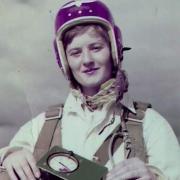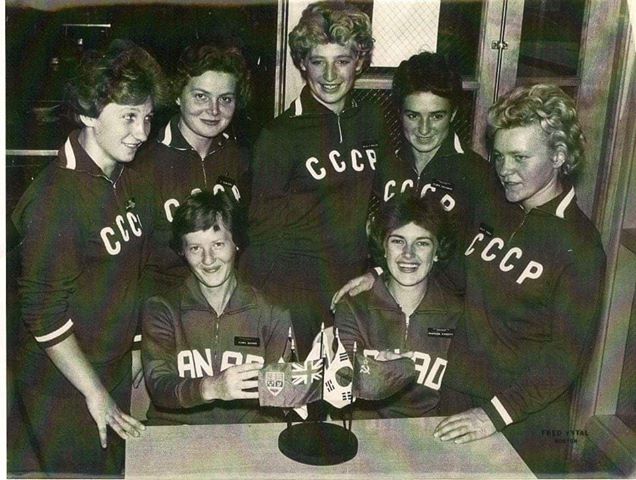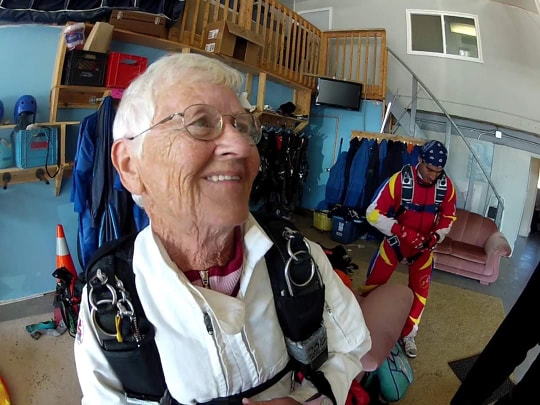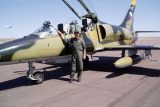Your Friend Abroad, Ilona
News
Posted by: International Skydiving Museum & Hall of Fame
5 years ago
By: Laura Jane Happick

We may imagine skydiving pioneers, the heroes of our sport, to be serious, stern, austere legends. Maybe some of them are, but Ilona certainly is not. Lively, energetic, plucky—these words more closely describe the personality of the woman whose cheery voice answers the phone for this interview.
There are individuals in this world, who within moments of speaking, give the impression that within their lives is a tale worth telling and a story worth knowing. This is definitely the case with Ilona Helwig. Ilona’s skydiving story gives great insight into the development of skydiving both on the world stage and closer to home.
Originally from Budapest, Hungary, Ilona made her first skydive in the middle of June 1952, shortly before turning 15. Initially, Ilona had been interested in gliding after a fellow classmate picked up the hobby. While in the gliding club meeting, Ilona overheard that another member would be making a parachute jump. As Ilona puts it “I thought oh boy, that’s really something! So, I went to the parachute club, and that’s how it started.”
Within three years of beginning skydiving and with only 40-50 jumps under her belt, Ilona became the Hungarian female champion. In 1956, Ilona became the over-all female Hungarian champion as well as a champion in the discipline that would come to be known as “Style.” Though this early on, the jumps consisted of one “figure 8” in which the jumper would begin on heading and turn to the right and then to the left, like a figure 8.
Though the notion seems beyond belief, it is important to keep in mind that though we may now have body-flight on nearly every axis imaginable, each of these axis’ had to, at one point, be discovered. At the start, in the early days of skydiving, the sport was limited to stable, relative freefall. For example, as Ilona recalls, it wasn’t until 1962 that the women’s competition added a second figure 8 and a back loop.
In 1956, Ilona represented Hungary in Moscow at the third ever World Championships. This was also the first year the U.S men’s team competed on the world stage in skydiving. During this competition, 4 years after beginning skydiving, Ilona made her 100th skydive, and as she recalls, so did U.S skydiving pioneer and D License number 1, Lew Sanborn.
Shortly after the 1956 World Championship, there was a revolution in Ilona’s home country of Hungary. This revolution began in October and ended at the beginning of November. Despite the upheaval of having to emigrate from her homeland, Ilona, in what seems typical fashion, made the most of her circumstances:
“I left Hungary the last day of the revolution—with nothing but my logbook in my pocket. I went to Austria. I was put in a refugee camp, and after Christmas, they asked us where we wanted to go to. I said Canada. Canada is my chosen country, and it’s a great country. Even though, I didn’t speak any English [in Canada] I was at home.”
Once in Canada, Ilona has a simple, well-timed piece of journalism to thank for her ability to continue skydiving: “There was an article about me that I was a refugee and a skydiver, and the Canadian skydiving club got in touch with me.”

In 1962, Ilona became a Canadian citizen and was able to join the Canadian team. At this time, Ilona also became the earliest Canadian licensed female. Her skydiving licenses include B-13, C-11, and D-7.
Once again, Ilona demonstrated her skydiving aptitude and became a champion. Also, in 1962, Ilona was sent with the women’s team to Orange, Massachusetts to represent Canada in the 7th World Championships.
With a chuckle, Ilona says of the 1962 World Championships: “I didn’t win anything, but it was a good time.”
In 1964, Ilona earned her spot as Canadian champion again, and along with the Canadian women’s team, traveled to represent Canada in Germany. Though Ilona did not medal individually, the Canadian women’s team took fifth. Despite being fairly competitive during her skydiving career, Ilona’s favorite part of competition was meeting people. She says “maybe that’s why I didn’t excel as much as I should have. I was having so much fun.”
At 27 years old, Ilona left skydiving and turned her attention to other forms of competition. Upon returning home, Ilona met her husband and began showing Hungarian sheepdogs, also known as Pulis. As in skydiving, Ilona was a champion. One of her dogs was Best Pup at the American Specialty and the other, Adam, was Winners Dog Best of Winners at the American Specialty as well as one of the top dogs in Canada.

Despite a sabbatical, Ilona wasn’t done with skydiving. In 2010 a group of friends, including Daryl Henry, holder of Canada’s License D-3 and member of the Skydiving Hall of Fame, got together at the dropzone in Canada where they met back in 1958, the Parachute School of Toronto in Baldwin, Ontario. Here Ilona made a static line jump and began AFF. From 2011 at the age of 74, to 2014 at the age of 77, Ilona made 102 jumps. As she puts it, “not bad for an old woman!”
“I did a number of things I didn’t get to do before I “retired”—like head down with Marc-Olivier Pinault, and I did an 8 way. I was only back for 5 jumps and then did the 8 way. And I had a good time. I love my dropzone. I even sold my house and moved half an hour from the dropzone.”
Though she is no longer jumping, about twice a year, Ilona makes a trip to her old dropzone to visit friends and share her knowledge with new skydivers. As a female skydiving pioneer, Ilona is especially excited about the increased presence of female skydivers in the sport: “I love watching students at my club, especially women. I am very supportive of the girls, and it feels really good when they do well.” Her advice for up and coming skydivers is profound in its simplicity: “try to be safe, do your best, and enjoy.”
Today, Ilona enjoys playing with her nieces’ big German Shepherd pup, staying active in the gym, and keeping in touch with skydivers around the world on Facebook. If you have the chance, look her up and send her a message, you’re in for a treat.
Categories:
You May Be Interested In:

2025 Path & Pioneers of Excellence Recipients Revealed!
3 weeks ago by Nancy Kemble Wilhelm

Congratulations to Museum Trustee Sherry Butcher!
1 month ago by Nancy Kemble Wilhelm

Don Kirlin Joins Board of Trustees
3 months ago by Nancy Kemble Wilhelm

Congratulations Hall of Fame Class of 2025!
4 months ago by International Skydiving Museum & Hall of Fame
Join the Mission
Be Part of Skydiving History
As a nonprofit organization, we are counting on investments of time, talent, and resources from our collective community to make the International Skydiving Museum & Hall of Fame a reality.
